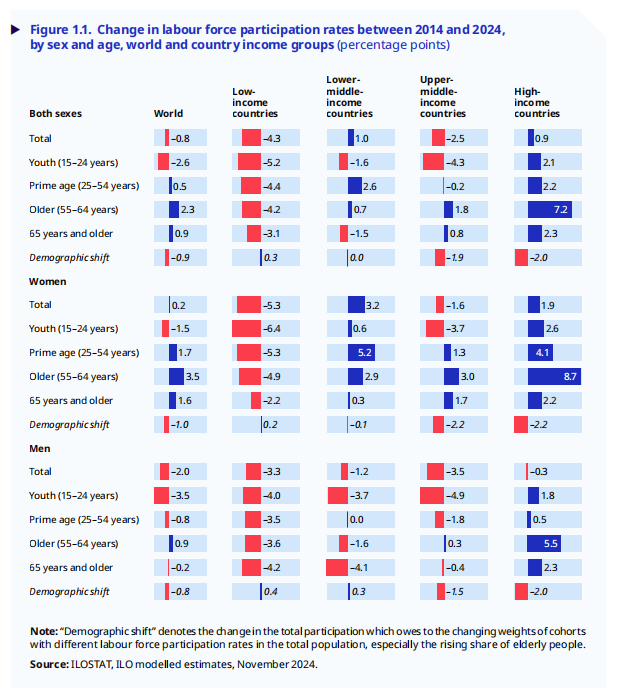The International Labour Organisation (ILO) has highlighted the persistent challenge of structural imbalances in the labour markets of low-income countries. Slowing economic growth has created bottlenecks in job creation and improvements in working conditions, while technological innovation has underdelivered on expectations to boost productivity and improve living standards. Youth unemployment is particularly acute: young people in low-income countries face weak competitiveness in the job market due to scarce educational resources and inadequate vocational skills, highlighting the critical need for stronger links between education and employment. Additionally, stagnant trade and restricted labour mobility further hinder the healthy development of labour markets. The ILO’s World Employment and Social Outlook: Trends 2025 aims to synthesise global wisdom and experiences, promoting coordinated policies at national, regional, and global levels to address employment challenges and advance social justice through systemic solutions.
I Current Status and Challenges in the Global Job Market
In 2024, global employment expanded alongside labour force growth, keeping the unemployment rate stable at around 5%, similar to 2023. Beneath this seemingly positive figure lie deeper issues: weak employment growth, a severe “decent work deficit,” and failure to make significant progress toward Sustainable Development Goals SDGs), particularly regarding informal employment, gender equality, and youth employment. These structural problems not only limit individual and societal potential but also threaten the global economy’s sustainable growth.
Global economic growth stood at 3.2% in 2024, down from 3.3% in 2023 and 3.6% in 2022. While inflation eased, wage growth failed to fully offset income losses from the COVID-19 pandemic. A decline in investment rates and rising energy prices further impacted industrial production, constraining labour market improvements. The globallabourr force participation rate (LFPR) is projected tstabiliseze at 61.0% in 2024, temporarily halting its long-term downward trend. However, this masks stark regional disparities: LFPR slightly declined in low-income countries; in upper-middle and high-income countries, declines were driven by population ageing; while in lower-middle-income countries, increases were fueled by rising rural women’s participation in India.
Over the past decade, global LFPR dropped by 0.8%, primarily due to structural declines in low-income and upper-middle-income countries and ageing populations in high-income and some upper-middle-income countries. Contrary to the global trend, women’s participation rose in high-income and lower-middle-income countries. In fact, without demographic changes, global LFPR would have increased by 0.1% over the decade. In middle-income countries, women’s participation rose significantly in certain age groups, while young men’s participation fell far below the global average, reflecting greater challenges in integrating into the labour market.

Despite accelerating ageing, high-income countries saw substantial LFPR growth in recent years, driven by women and those aged 55–64 reentering the workforce. This growth countered demographic headwinds: without such gains, ageing would have reduced their total LFPR by 2%.

Gender gaps inlabourr participation remain pronounced, with far fewer women than men engaged in the workforce, indicating untapped potential for improving living standards. In some regions, narrowing gaps resulted from declining male, especially young male, participation, not rising female participation. Alarmingly, the share of young men in NEET (Not in Employment, Education, or Training) status has increased globally, particularly in low-income countries, where it exceeds historical averages by nearly 4 percentage points, leaving them ill-prepared for the labour market and vulnerable to shocks.
II. Regional Employment and Social Trends
1. Africa: Balancing Economic Growth and Employment Challenges
Africa’s GDP is projected to grow by 3.3% in 2024 and 4.1% in 2025, but growth is hindered by slow per capita GDP expansion. North Africa and Sub-Saharan Africa exhibit divergent trends: in North Africa, working-age population growth outpaces employment and labour force growth, lowering LFPR and the employment-to-population ratio. With a 2024 working-age population of 185 million, the region faces one of the world’s highest youth unemployment rates—22.8% for 15–24-year-olds (second only to Arab countries’ 27.5%), with young women hit hardest at 37.9%. Sub-Saharan Africa struggles with informal employment (86.6% of jobs) and working poverty, with 62.6% of households below the moderate poverty line.
2. The Americas: Inequality and Low Productivity Hamper Progress
While most of the Americas saw slowing GDP growth, unemployment remained stable, with 2024 growth at 2.4% (projected 2.3–2.5% in 2025). Latin America and the Caribbean suffer from severe labour market segmentation, with informal employment accounting for 52% of jobs. Gender disparities persist, with a 62.6% overall LFPR but a stark gap—74.6% male vs. far lower female participation. In North America, the U.S. and Canada face dual challenges of ageing populations and skills mismatches, leading tolabourr shortages in STEM and ICT sectors. Canada’s 2021 legislation aims to address this through targeted skilled immigration.
3. Arab States: Pronounced Gender Gaps and Youth Unemployment
Arab states exhibit diverging paths between oil exporters and importers. A rebound pushed 2024 GDP growth to 1.5% (up from 0% in 2023), with 4.1% projected for 2025. Non-GCC economies lagged in 2024 (0.5%) but are set to rise to 3.7% in 2025. Labour markets feature extreme gender disparities: a 49.2% overall LFPR in 2024, driven by just 19.2% female participation (vs. 73.6% male). As these countries integrate AI and digital technologies, efforts must ensure gender-inclusive benefits to avoid exacerbating gaps.
4. Asia and the Pacific: Growth Engines and Employment Hurdles
The region’s growth is uneven, with South and Southeast Asia as engines and East Asia slowing. Asia-Pacific GDP grew 4.4% in 2024 (4.3% projected for 2025). East Asia, despite 3.8% growth in 2024, lags behind its pre-COVID 5.8% average, driven by China’s structural slowdown. South Asia, led by India, surged at 6.2% in 2024 (5.8% in 2025) but faces a massive gender gap (31.4% female vs. 76.7% male LFPR) and pervasive informal employment and working poverty.
5. Europe and Central Asia: Labour Shortages and Slowing Productivity
The region maintained steady growth at 1.8% in 2024 (1.9% projected for 2025), with stark subregional differences: Nordic, Southern, and Western Europe grew just 1% in 2024, while Eastern Europe and Central Asia saw stronger growth. Persistent labour shortages in STEM and ICT sectors, combined with slow productivity growth, threaten wage growth and social equity, calling for integrated policies to address skills mismatches and regional disparities.
III. Pathways to Solutions
1. Tackling Slowing Productivity
Global productivity growth has underwhelmed despite technological advances, partly due to spatial inequalities—concentrated economic activity exacerbates resource disparities and stifles overall productivity. Governments must design integrated industrial and social policies: improving infrastructure and public services to foster regional balance, promoting economic diversification and innovation, and enhancing education and training. However, policies must avoid congestion effects in underserved regions.
2. Crafting Strategic Industrial Policies
Industrial policies are vital for growth and employment, but face challenges in targeting effectiveness, balancing regional interests, and avoiding worsened inequalities. Solutions include stronger policy coordination, evidence-based design, and rigorous monitoring. Investing in physical (transport, energy) and digital (5G, data centres) infrastructure can equitably allocate resources and support inclusive growth, complemented by international collaboration to enhance policy impacts.
More details:
https://www.ilo.org/publications/flagship-reports/world-employment-and-social-outlook-trends-2025
Sources: International Labour Organisation, January 16, 2025
Li Yingying, Research Institute for International and Comparative Education, Shanghai Normal University




